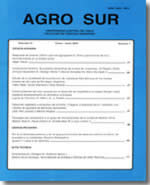Floristic composition of the high andean prairies of the Lonquimay zone (IX Region, Chile).
Main Article Content
Abstract
The objective of the study was to determine the floristic composition of high Andes pastures in the sector of Lonquimay. In seven summer pastures , intensive collections and inventories of the vegetation were conducted using the European phytosociological method. A total of 117 species were observed, including a pteridophyte, a gymnospermae and 115 angiospermae. Of these, 19,7% are introduced species, demonstrating that there has been a relatively low degree of anthropic alteration, despite the evident deterioration due to overgrazing in some of these areas. The most important life forms observed were hemicryptophytes, nanophanerophytes and terophytes, which would be related to the climatic conditions of the zone. From the vegetation point of view, two large herbaceous formations were predominant in the area of the study: the steppe or “coironal” and the wet prairie or “mallín”. The coironal was very rich in species and the mallín had the highest forage value.

